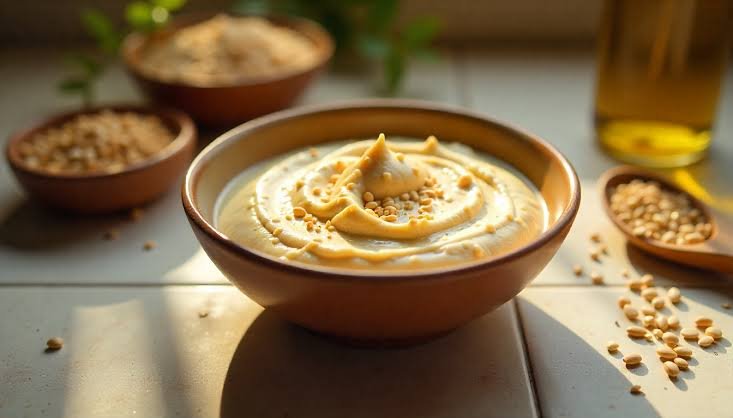Blog
Tahhiini Benefits & Uses: A Complete Guide

Tahhiini has become a popular superfood worldwide due to its incredible nutrition and versatility. Many people confuse it with tahini, but carries its own uniqueness in flavor, preparation, and health benefits. Whether you’re looking to enrich your diet with plant-based protein or searching for a smooth, nutty paste to enhance your dishes, is an excellent choice.
In this guide, you’ll learn everything about —its origins, nutritional profile, health advantages, recipes, and storage tips.
What is Tahhiini?
Origin and History of Tahhiini
Tahhiini traces its roots back to the Middle East, where sesame seeds have been a staple for thousands of years. Ancient civilizations used sesame not only for cooking but also for medicinal purposes. Over time, sesame seeds were ground into a fine paste, creating —a smooth, creamy spread that remains central in both traditional and modern cuisines.
How Tahhiini Differs from Tahini
Although the words tahhiini and tahini sound similar, they may refer to slightly different preparations. often uses roasted sesame seeds, which gives it a stronger, nuttier taste compared to regular tahini made from raw seeds. This subtle difference changes both the flavor and nutritional profile, making a preferred choice for those who enjoy deeper flavors.
Nutritional Value of Tahhiini
Macronutrients in Tahhiini
Tahhiini is packed with essential nutrients. Just two tablespoons provide:
- Calories: Around 180
- Protein: 5 grams
- Fat: 16 grams (mostly healthy fats)
- Carbohydrates: 3 grams
- Fiber: 2 grams
This balance makes tahhiini an energy-dense food, ideal for people following plant-based or high-protein diets.
Vitamins and Minerals
Tahhiini also supplies key micronutrients such as:
- Calcium – vital for bone strength
- Magnesium – supports nerve function
- Iron – boosts red blood cell production
- Zinc – strengthens immunity
- Vitamin B1 – improves metabolism
Health Benefits of Tahhiini
Supports Heart Health
The healthy fats in tahhiini—especially monounsaturated and polyunsaturated fats—help lower bad cholesterol levels. This reduces the risk of heart disease and supports overall cardiovascular wellness.
Boosts Digestive Health
Rich in dietary fiber, tahhiini aids digestion and promotes gut health. It helps regulate bowel movements, preventing constipation while feeding good bacteria in the intestines.
Strengthens Bone
The calcium and phosphorus content in contribute to strong bones and teeth. For individuals who avoid dairy, acts as a fantastic plant-based alternative for maintaining bone health.
Provides Plant-Based Protein
With its impressive protein content, fuels muscle repair and growth. Vegetarians and vegans often rely on as a protein source in their meals.
How to Make Tahhiini at Home
Ingredients You Need
- 2 cups sesame seeds
- 2–3 tablespoons olive oil or sesame oil
- A pinch of salt (optional)
Step-by-Step Preparation
- Roast sesame seeds lightly until golden brown.
- Allow them to cool before blending.
- Transfer seeds into a food processor.
- Blend until smooth, adding oil gradually for consistency.
- Store in an airtight jar.
This homemade is fresher and healthier than store-bought options, free from preservatives or additives.
Culinary Uses of Tahhiini
Tahhiini in Middle Eastern Cuisine
Traditional dishes like hummus, baba ghanoush, and falafel sauces wouldn’t taste the same without tahhiini. Its nutty flavor balances spices and creates a rich, creamy texture.
Modern Recipes with Tahhiini
In recent years, chefs worldwide have adopted in creative ways. It’s now used in:
- Smoothies for extra protein
- Salad dressings for creaminess
- Baked goods like brownies and cookies
- Sauces for grilled vegetables and meats
Storage Tips for Fresh Tahhiini
To keep fresh:
- Store in a cool, dry place.
- Refrigerate after opening to extend shelf life.
- Stir before use, as natural oils may separate.
Common Mistakes to Avoid
- Using too much oil during preparation, which makes it runny.
- Storing it at room temperature for too long.
- Skipping roasting if you want a strong flavor.
Frequently Asked Questions (FAQs)
1. Is tahhiini the same as tahini?
Not exactly. Tahhiini is often made with roasted seeds, giving it a deeper flavor.
2. Can tahhiini be eaten daily?
Yes, in moderation. It’s nutrient-rich but also calorie-dense.
3. Is tahhiini suitable for vegans?
Absolutely! It’s 100% plant-based.
4. Can tahhiini be used as a peanut butter substitute?
Yes, it works well as a nut-free alternative in spreads and recipes.
5. How long does homemade tahhiini last?
When refrigerated, it can last up to 3–4 weeks.
6. Does tahhiini contain gluten?
No, it’s naturally gluten-free.
Conclusion
Tahhiini isn’t just a flavorful paste; it’s a powerhouse of nutrition and culinary versatility. From promoting heart health to strengthening bones and enriching plant-based diets, offers benefits that make it a must-have in every kitchen. Whether you enjoy it in traditional Middle Eastern dishes or modern recipes, proves to be both delicious and nourishing.
-

 Blog2 months ago
Blog2 months agoKate Garraway’s New Partner 2024: A Fresh Chapter Begins
-

 Health2 months ago
Health2 months agoCandizi – The Ultimate Game-Changer in Wellness and Lifestyle
-

 Food2 months ago
Food2 months agoCalamariere: A Tasty Seafood Delight That Shines
-

 Blog2 months ago
Blog2 months agoUnited Airlines Flight UA770 Emergency Diversion
-

 Blog2 months ago
Blog2 months agoTractor Supply Sales Associate Job Description (2025 Update)
-

 Blog2 months ago
Blog2 months agoPowerful 7-Step Guide to هنتاوي com: Boost Organic Traffic Now
-

 Culture2 months ago
Culture2 months agoHis Majesty NWBKA: A Symbol of Royalty, Culture, and Legacy
-

 digital marketing2 months ago
digital marketing2 months agoSalt Lake City Videography Services That Bring Your Vision to Life
